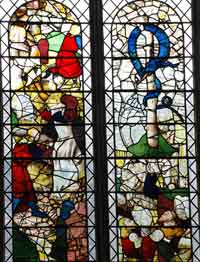Stained Glass Makers through the Centuries
Years of Decline
 In the early 16th century, stained glass production continued to flourish in Norwich. Although some windows continued to have a distinct Gothic style, artisans were beginning to be influenced by continental craftsmen, particularly by the Flemmish and French. This new style can be seen in the 1509 window in St Andrew's, Norwich, which depicts the sacrifice of Issac and the raising of the Brazen Serpent. At the same time, as a result of the Renaissance and the employment of foreign artists in England, figures and scenes were becoming more realistic, see St Peter Hungate’s east window for the clear contrast in styles. Despite this there is no record of foreign glaziers active in Norwich at this time.
In the early 16th century, stained glass production continued to flourish in Norwich. Although some windows continued to have a distinct Gothic style, artisans were beginning to be influenced by continental craftsmen, particularly by the Flemmish and French. This new style can be seen in the 1509 window in St Andrew's, Norwich, which depicts the sacrifice of Issac and the raising of the Brazen Serpent. At the same time, as a result of the Renaissance and the employment of foreign artists in England, figures and scenes were becoming more realistic, see St Peter Hungate’s east window for the clear contrast in styles. Despite this there is no record of foreign glaziers active in Norwich at this time.
However, from the mid-16th to the 19th century not only was much earlier work destroyed, but little new glass was produced. The biggest blow in the 16th century came in the 1547 injunctions of Edward VI which categorically stated 'They shall take away, utterly extinct and destroy all...pictures, paintings…of feigned miracles, pilgrimages, idolatry and superstition; so that there remain no memory of the same in walls, glass windows, or elsewhere within their churches or houses.' With the removal of religious subject matter from the repertoire of stained glass artists virtually all that remained to produce was heraldry.
If this weren't enough in 1633 the Lorraine glass houses, which were a primary source of pot metal glass, were destoyed which resulted in this commodity being rarely used in England for nearly 200 years.The position did not improve during the Civil War and the founding of the Commonwealth which, with its attack on 'idolatry' led to a further destruction of religious glass.
After almost 200 years of decline, by the late 18th Century the glass staining and painting industry in England has all but disappeared, firms which survived in Norwich relied on heraldic glazing.